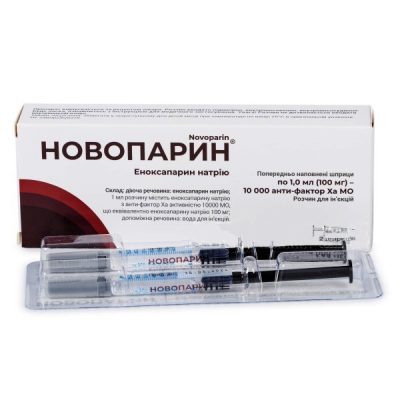Registration certificate of the Ministry of Health of Ukraine UA/9061/01/01 with unlimited validity from March 25, 2020

ANTITHROMBOTIC AGENTS. HEPARIN GROUP. ENOXAPARIN.

The drug is registered in the European Union under a centralized procedure.

The lowest level of reports of adverse reactions among enoxaparins in the markets where the drug is presented.

The manufacturer has GMP certificates issued by MHRA, EU EMA, Australia TGA and Brazil ANVISA
Proven results
Novoparin is a proven choice in anticoagulant therapy.

Treatment of deep vein thrombosis
Treatment of deep vein thrombosis (DVT) and pulmonary embolism (pulmonary embolism), except for pulmonary embolism, which may require thrombolytic therapy or surgery. Prevention of thrombus formation in extracorporeal circulation during hemodialysis.

Patients with Acute Coronary Syndrome
Treatment of acute myocardial infarction with ST segment elevation (STEMI), including patients undergoing medical treatment or with further percutaneous coronary intervention (PCI).

Prevention of venous thromboembolism
Prevention of venous thromboembolism in medical patients with acute diseases (eg acute heart failure, respiratory failure, severe infections or rheumatic diseases) and reduced mobility with an increased risk of venous thromboembolism.

THE FIRST BIOSIMILARY IN THE EU SINCE 2016
* Introduced in the EU under the trade name Inhixa drug took 15.65% of the Enoxaparin market.
SELF-TREATMENT CAN BE HARMFUL TO YOUR HEALTH
INDICATIONS
The drug is indicated for use by adults for:
- Prevention of venous thromboembolic complications in surgical patients at moderate and high risk, especially in patients undergoing orthopedic or general surgery, including surgery for cancer.
- Prevention of venous thromboembolic complications in therapeutic patients with acute diseases (such as acute heart failure, respiratory failure, severe infections or rheumatic diseases) and reduced mobility who are at increased risk of venous thromboembolism.
- Treatment of deep vein thrombosis (DVT) and pulmonary embolism (pulmonary embolism), except in cases of pulmonary embolism, which may require thrombolytic therapy or surgery.
- Prevention of thrombus formation in the extracorporeal circulation during hemodialysis.
- In acute coronary syndrome:
- for the treatment of unstable angina and myocardial infarction without ST-segment elevation (NSTEMI), in combination with oral acetylsalicylic acid;
- for the treatment of acute ST-segment elevation myocardial infarction (STEMI), including in patients undergoing medical treatment or subsequent percutaneous coronary intervention (PCI).
DOSAGE
Prevention of venous thromboembolic complications in surgical patients at moderate and high risk.
Individual thromboembolic risk in patients can be assessed using a validated risk stratification model (scale).
- For patients with a moderate risk of thromboembolic events, the recommended dose of enoxaparin sodium is 2000 IU (20 mg) once daily by subcutaneous injection. Preoperative initial administration (2 hours before surgery) of enoxaparin sodium at a dose of 2000 IU (20 mg) has been shown to be effective and safe in moderate-risk surgery.
In patients at moderate risk, prophylactic treatment with enoxaparin sodium should be continued for a period of at least 7–10 days, regardless of the state of recovery (eg mobility). Prevention should be continued until the patient no longer has significantly reduced mobility.
- For patients at high risk of thromboembolic events, the recommended dose of enoxaparin sodium is 4,000 IU (40 mg) once daily, preferably 12 hours before subcutaneous injection. If prophylactic use of enoxaparin sodium is required more than 12 hours before surgery (for example, a high-risk patient expecting delayed orthopedic surgery), the last injection should be given no later than 12 hours before surgery and resumed. preventive use 12 hours after surgery.
- Prolonged thromboprophylaxis of up to 5 weeks is recommended for patients undergoing major orthopedic surgery.
- Prolonged thromboprophylaxis of up to 4 weeks is recommended for patients at high risk of venous thromboembolism (VTE) who are undergoing surgery on the abdominal or pelvic organs for cancer.
Prevention of venous thromboembolism in therapeutic patients.
The recommended dose of enoxaparin sodium is 4000 IU (40 mg) once daily administered by intravenous injection.
- Prophylactic treatment with enoxaparin sodium should be carried out for a period of at least 6–14 days, depending on the state of recovery (eg mobility). The benefits of such treatment for more than 14 days have not yet been determined.
Treatment of deep vein thrombosis (DVT) and pulmonary embolism (pulmonary embolism).
Enoxaparin sodium should be administered intravenously as an injection of 150 IU / kg (1.5 mg / kg) once daily or as an injection of 100 IU / kg (1 mg / kg) twice daily.
The dosing regimen is chosen by the physician based on the results of the individual assessment, which should include an assessment of the risk of thromboembolic events and the risk of hemorrhagic events. The dosing regimen of 150 IU / kg (1.5 mg / kg) once daily should be used in patients without complications with a low risk of recurrence of VTE. The 100 IU / kg (1 mg / kg) dosing regimen should be administered twice daily to all other patients, such as obese, symptomatic pulmonary embolism, cancer, recurrent VTE, or thrombosis of the proximal veins (iliac vein).
ENOXAPARIN
Enoxaparin –it is low molecular weight heparin (LMWH) in which the antithrombotic and anticoagulant activities of standard heparin are not related. It has higher anti-factor Xa activity than anti-factor IIa (or antithrombin) activity (their ratio is 3.6).
When used in prophylactic doses, enoxaparin has no significant effect on APTT (activated partial thromboplastin time).
With the use of therapeutic doses of the drug APTT can be prolonged and 1.5–2.2 times higher than the control time of maximum activity. This prolongation reflects residual antithrombin activity.



